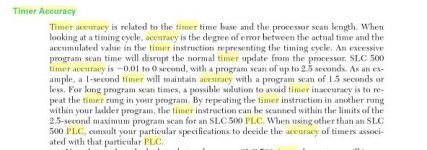daithi1979
Member
Hi All,
The company I work for has recently been audited and one of the sitings was that we are not calibrating our PLC timers. The question posed by the auditor was "If a process is controlled at a temp for x time how do we know the timer is correct"
I am having difficulty finding detailed information explaining that there is no standard to calibrate a PLC timer and also that PLC timers are stable. Has anyone come across this situation before?
Common sense is out the window here, looking for solid data to reply to the auditors
Many Thanks,
David.
The company I work for has recently been audited and one of the sitings was that we are not calibrating our PLC timers. The question posed by the auditor was "If a process is controlled at a temp for x time how do we know the timer is correct"
I am having difficulty finding detailed information explaining that there is no standard to calibrate a PLC timer and also that PLC timers are stable. Has anyone come across this situation before?
Common sense is out the window here, looking for solid data to reply to the auditors
Many Thanks,
David.









